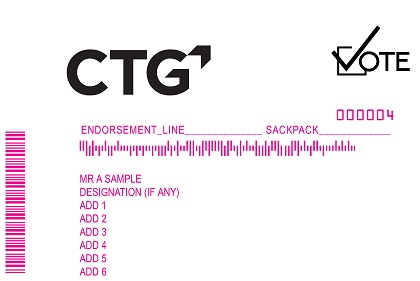Director Independence and Executive Sessions
The Board of Directors affirmatively determined in February 2018 that each of the Company’s fivesix current non-management directors which include(three of whom are also nominees for election), James R. Helvey III, David H. Klein, Valerie Rahmani, Raj Rajgopal, Kathryn A. Stein, and Daniel J. Sullivan, and Owen J. Sullivan, is anare independent directordirectors in accordance with our corporate governance policiesCorporate Governance Policies, a copy of which is available on our website (see “Corporate Governance and Website Information”), the rules of the SEC and the standards of the NASDAQ Stock Market (“NASDAQ”). As a result of these fivesix directors being independent, a majority of our Company’s Board of Directors is currently independent as so defined. The Board of Directors has determined that there are no relationships between the Company and the directors classified as independent other than service on our Company’s Board of Directors. William D. McGuire,The Board of Directors also previously determined that Owen J. Sullivan, who retired from the Board of Directors on February 16, 2017,effective July 1, 2021, was also an independent director and independent for purposes of“independent director” as defined by the committees on which he served.same standards noted above.
The foregoing independence determination also included the conclusions of the Board of Directors that:
each member of the Audit Committee, Nominating and Corporate GovernanceNCG Committee, and Compensation Committee described in this proxy statement is respectively independent under the standards listed above for purposes of membership on each of these committees; and
each of the membersmember of the Audit Committee also meets the additional independence requirements under Rule10A-3 of the Securities and Exchange Act of 1934, as amended (the “Exchange Act”).
Daniel J. Sullivan serveshas served as the ChairmanChair of the Board of Directors and is responsible for scheduling and setting the agenda for the executive sessions of the independent directors. Such executive sessions are expected to occur at regularly scheduled times during the fiscal year ending December 31, 2018,2021, typically in conjunction with a regularly scheduled Board meeting, in addition to the separate meetings of the standing committees of the Board of Directors.
The Board of Directors has also adopted a statement of corporate governance principles that is available on the Company’s website as described below under “Corporate Governance and Website Information.”
Audit Committee
The Audit Committee is composed of five directors: James R. Helvey III, Chairman, David H. Klein, Valerie Rahmani, Daniel J. Mr. Sullivan and Owen J. Sullivan, and operates under a written charter adopted bywill be retiring from the Board at the Annual Meeting of Directors. The charter of the Audit Committee is available on our Company’s website as described below under “Corporate Governance and Website Information.” The Audit Committee met five times during 2017.
The primary purposes of the Audit Committee are to oversee on behalf ofShareholders in accordance with the Company’s Board of Directors: (1) the accounting and financial reporting processes of the Company and integrity of the Company’s financial statements, (2) the audits of the Company’s financial statements and appointment, compensation, qualifications, independence and performance of the Company’s independent registered public accounting firm, (3) the Company’s compliance with legal and regulatory requirements, (4) the Company’s internal audit function, and (5) the preparation of the Audit Committee report that SEC rules require to be included in the annual proxy
8
statement. The Audit Committee’s job is one of oversight. Management is responsible for the Company’s financial reporting process including its system of internal control, and for the preparation of the Company’s consolidated financial statements in accordance with U.S. generally accepted accounting principles. The Company’s independent registered public accounting firm is responsible for auditing those financial statements. It is the Audit Committee’s responsibility to monitor and review these processes. It is not the Audit Committee’s duty or responsibility to conduct auditing or accounting reviews. Therefore, the Audit Committee has relied on management’s representation that the financial statements have been prepared with integrity and objectivity and in conformity with U.S. generally accepted accounting principles, on its discussions with the independent registered public accounting firm and on the representations of the Company’s independent registered public accounting firm included in its report on the Company’s financial statements.
The Board of Directors has determined that the members of the Audit Committee are independent as described above under “Director Independence and Executive Sessions” and that each of them is able to read and understand fundamental financial statements. The Board of Directors has determined that James R. Helvey III is an “audit committee financial expert” as defined in Item 407 of RegulationS-K. Under the rules of the SEC, the determination that a person is an audit committee financial expert does not impose on such person any duties, obligations or liability any greater than the duties, obligations and liability imposed on any other member of the Audit Committee or the Board of Directors. Moreover, the designation of a person as an audit committee financial expert does not affect the duties, obligations or liability of any other member of the Audit Committee or Board of Directors.
Audit Committee Report
The Audit Committee has reviewed and discussed the audited financial statements with management; and has discussed with the Company’s independent auditors the matters required to be discussed pursuant to PCAOB Auditing Standard No. 16, as amended. In addition, the Audit Committee has received the written disclosures and the letter from the independent registered public accountant required by applicable requirements of the Public Company Accounting Oversight Board regarding the independent registered public accountant’s communications with the Audit Committee concerning independence, and has discussed with the independent registered public accountant the independent registered public accountant’s independence.
Based on the review and discussions referred to above, the Audit Committee has recommended to the Board of Directors that the audited financial statements be included in the Company’s Annual Report on Form10-K for the last fiscal year for filing with the SEC.
Submitted by the Audit Committee
James R. Helvey III, Chairman
David H. Klein
Valerie Rahmani
Daniel J. Sullivan
Owen J. Sullivan
Nominating and Corporate Governance Committee and Director Nomination Process
The Nominating and Corporate Governance Committee is composed of David H. Klein, Chairman, James R. Helvey III, Valerie Rahmani, Daniel J. Sullivan, and Owen J. Sullivan. This Committee held three meetings during 2017.
This Nominating and Corporate Governance Committee has a charter that is available on our Company’s website as described below under “Corporate Governance and Website Information.” The primary purposes of
9
the Committee are to (a) identify and select the individuals qualified to serve on the Company’s Board of Directors for election by shareholders at each annual meeting of shareholders and to fill vacancies on the Board of Directors, (b) implement the Board’s criteria for selecting new directors, (c) develop, recommend to the Board, and assess corporate governance policies for the Company, and (d) oversee the evaluation of the Board.
The Board of Directors has determined that the members of the Nominating and Corporate Governance Committee are independent as described above under “Director Independence and Executive Sessions.”
Director Nominations Made by Shareholders. The Nominating and Corporate Governance Committee will consider nominations timely made by shareholders pursuant to the requirements of ourBy-laws, which are further discussed under “Shareholder Proposals.” The Nominating and Corporate Governance Committee has not formally adopted any specific elements of this policy, such as minimum specific qualifications or specific qualities or skills that must be possessed by qualified nominees, beyond the Nominating and Corporate Governance Committee’s willingness to consider candidates proposed by shareholders.
Procedure for Shareholders to Nominate Directors. Any shareholder who intends to present a director nomination proposal for consideration at an annual meeting of shareholders may use the procedures set forth in the Company’sBy-laws. For shareholder nominations of directors to be properly brought before an annual meeting by a shareholder pursuant to theBy-laws, the shareholder must have given timely notice thereof in writing to the Secretary of the Company. Subject to the rights of the holders of any class or series of stock having a preference over the Company’s common stock as to dividends or upon liquidation, nominations for the election of directors may be made by or at the direction of the Board of Directors or by any shareholder entitled to vote for the election of directors who complies with the following procedures. Any shareholder entitled to vote for the election of directors at a meeting may nominate persons for election as directors only if written notice of such shareholder’s intent to make such nomination is given, either by personal delivery or by United States mail, postage prepaid, to and received by the Secretary of the Corporation by the close of business at the principal executive offices of the Company (i) with respect to an election to be held at a special meeting of shareholders for the election of directors, the close of business on the 10th day following the date public announcement of the date of such meeting is first made and (ii) with respect to an election to be held at an annual meeting of shareholders, not less than 90 and not earlier than 120 days prior to theone-year anniversary of the date of the preceding year’s annual meeting of shareholders; provided, however, that if the meeting is convened more than 30 days prior to or delayed by more than 60 days after theone-year anniversary of the date of the preceding year’s annual meeting, or if no annual meeting was held in the preceding year, notice by the shareholder of record to be timely must be so received not earlier than the close of business on the 120th day prior to the date of the annual meeting and not later than the close of business on the later of (1) the 90th day before the date of such annual meeting or (2) if the first public announcement of the date of such annual meeting is less than 100 days prior to the date of such annual meeting, the 10th day following the day on which public announcement of the date of such meeting is first made. In no event shall an adjournment or postponement of an annual meeting of shareholders for which notice has been given, commence a new time period (or extend any time period) for the giving of a notice by a shareholder.
Each such notice shall set forth as to the shareholder giving the notice and the beneficial owner or owners, if any, or other persons on whose behalf the nomination is made or acting in concert therewith (each, a “party”): (1) the name and address of such party; (2) a representation that the shareholder giving the notice is a holder of record of stock of the Company entitled to vote at such meeting and intends to appear in person or by proxy at the meeting to nominate the person or persons specified in the notice; (3) the class, series, and number of shares of the Company that are owned, directly or indirectly, beneficially and of record by each such party; (4) any option, warrant, convertible security, stock appreciation right, or similar right with an exercise or conversion privilege or providing for a settlement payment or mechanism based on the price of any class or series of shares of the Company or with a value derived in whole or in part from the value of any class or series of shares of the Company, whether or not such instrument or right shall be subject to settlement in the underlying class or series of capital stock of the Company or otherwise (a “Derivative Instrument”) directly or indirectly owned beneficially by each such party, and any other direct or indirect opportunity to profit or share in any profit
10
derived from any increase or decrease in the value of shares of the Company; (5) any proxy, contract, arrangement, understanding or relationship pursuant to which any party, either directly or acting in concert with another person or persons, has a right to vote, directly or indirectly, any shares of any security of the Company; (6) any short interest or other borrowing arrangement in any security of the Company held by each such party (for purposes of this provision, a person shall be deemed to have a short interest in a security if such person directly or indirectly, through any contract, arrangement, understanding, relationship or otherwise, has the opportunity to profit or share in any profit derived from any decrease in the value of the subject security), (7) any rights to dividends on the shares of the Company owned beneficially directly or indirectly by each such party that are separated or separable from the underlying shares of the Company, (8) any proportionate interest in shares of the Company or Derivative Instruments held, directly or indirectly, by a general or limited partnership in which any party is a general partner or, directly or indirectly, beneficially owns an interest in a general partner and (9) any performance-related fees (other than an asset-based fee) that each such party is directly or indirectly entitled to based on any increase or decrease in the value of shares of the Company or Derivative Instruments, if any, as of the date of such notice, including without limitation any such interests held by members of each such party’s immediate family sharing the same household (which information set forth in this paragraph shall be supplemented by such shareholder or such beneficial owner or other person, as the case may be, not later than 10 days after the record date for the meeting to disclose such ownership as of the record date); (10) any other information relating to each such party that would be required to be disclosed in a proxy statement or other filings required to be made in connection with solicitations of proxies for, as applicable, the proposal and/or for the election of directors in a contested election pursuant to Section 14 of the Exchange Act (whether or not such party intends to deliver a proxy statement or conduct its own proxy solicitation); and (11) a statement as to whether or not each such party will deliver a proxy statement and form of proxy to holders of at least the percentage of voting power of all of the shares of common stock reasonably believed by such party, to be sufficient to elect the persons proposed to be nominated by the shareholder.
Each such notice shall also set forth as to each person whom the shareholder proposes to nominate for election or reelection as a director: (1) a description of all arrangements or understandings between the shareholder and each nominee and any other person or persons (naming such person or persons) pursuant to which the nomination or nominations are to be made by the shareholder; (2) the name and address of each such nominee; (3) such other information regarding each nominee proposed by such shareholder as would have been required to be included in a proxy statement filed pursuant to the proxy rules of the Securities and Exchange Commission had each nominee been nominated, or intended to be nominated, by the Board of Directors; (4) a written representation and agreement of each nominee (in the form provided by the Secretary of the Company upon written request) that such nominee would be in compliance, if elected as a director of the Company,retirement age guidelines and will comply with all corporate governance, conflict of interest, confidentiality and stock ownership and trading policies and guidelines of the Company; (5) the consent of each nominee to serve as a director of the Company if so elected and (if applicable) to being named in the Company’s proxy statement and form of proxy as a nominee; and (6) the written representation and agreement of each nominee that such nominee currently intends to serve as a director of the Companynot stand for the full term for which such person would be standing for election, if elected.re-election.
A shareholder providing notice of a nomination for the election of a director shall further update and supplement such notice, if necessary, so that the information provided or required to be provided in such notice shall be true and correct as of the record date for the meeting and as of the date that is 10 business days prior to the meeting or any adjournment or postponement thereof, and such update and supplement shall be delivered to, or mailed and received by, the Secretary at the principal executive offices of the Company not later than five business days after the record date for the meeting (in the case of the update and supplement required to be made as of the record date), and not later than five business days prior to the date for the meeting, if practicable (or, if not practicable, on the first practicable date prior to) any adjournment or postponement thereof (in the case of the update and supplement required to be made as of 10 business days prior to the meeting or any adjournment or postponement thereof). In addition, a shareholder must also comply with all applicable requirements of the Securities Exchange Act and the rules and regulations thereunder with respect to matters described above.
11
Board Composition and Diversity. The Nominating and Corporate Governance Committee’s current process for identifying and evaluating nominees for director consists of general periodic evaluations of the size and composition of the Board of Directors with a goal of maintaining continuity of appropriate industry expertise and knowledge of the Company. The Nominating and Corporate Governance Committee strives to compose the Board of Directors with individuals possessing a variety of complementary skills.
With respect to the nominees for election at this meeting and with respect to the other members of the Board, the Nominating and Corporate Governance Committee and the Board of Directors as a whole focused primarily on the experience, qualifications, attributes and skills discussed in each of the director’s biographies set forth above. In each case, the Nominating and Corporate Governance Committee and the Board of Directors considered important the achievements of the individual in the successful career described. With regard to Mr. Crumlish, the Nominating and Corporate Governance Committee and the Board believe that it is important that they have immediate access to his direct involvement in the management of the Company. With regard to Mr. Helvey, the Nominating and Corporate Governance Committee and the Board particularly noted his extensive financial experience and prior audit committee experience. With regard to Mr. Klein, the Nominating and Corporate Governance Committee and the Board particularly noted his extensive experience managing health plan entities and his knowledge of the healthcare industry – which is an important market for the Company’s services. With regard to Ms. Rahmani, the Nominating and Corporate Governance Committee and the Board particularly noted her experience in cyber-security and her extensive management experience within the IT Services industry. With regard to Mr. Daniel J. Sullivan, the Nominating and Corporate Governance Committee and the Board particularly noted the broad perspective resulting from his diverse experience in managing and serving as an officer for a large, public company. With regard to Mr. Owen J. Sullivan, the Nominating and Corporate Governance Committee and the Board particularly noted his extensive experience in the staffing solutions and professional resourcing industry, including his roles at ManpowerGroup.
Although diversity may be a consideration in the Nominating and Corporate Governance Committee’s process, the Nominating and Corporate Governance Committee and the Board of Directors do not have a formal policy with regard to the consideration of diversity in identifying director nominees. Since neither the Board nor the Nominating and Corporate Governance Committee has received any shareholder nominations in the past, the Nominating and Corporate Governance Committee has not considered whether there would be any differences in the manner in which the Committee evaluates nominees for director based on whether the nominee is recommended by a shareholder.
Source of Recommendation for Current Nominees. The nominees for director included in this proxy statement have been formally recommended by the incumbent independent directors who serve on the Nominating and Corporate Governance Committee.
Past Nominations from More Than 5% Shareholders.Under the SEC rules (and assuming consent to disclosure is given by the proponents and nominee), the Company must disclose any nominations for director made by any person or group beneficially owning more than 5% of the Company’s outstanding common stock received by the Company by the date that was 120 calendar days before the anniversary of the date on which its proxy statement was sent to its shareholders in connection with the previous year’s annual meeting. The Company did not receive any such nominations.
Shareholder Communications to the Board of Directors
Any record or beneficial owner of the Company’s common stock who has concerns about accounting, internal accounting controls, auditing matters or any other matters relating to the Company and wishes to communicate with the Board of Directors on such matters may contact the Audit Committee directly. The Audit Committee has undertaken on behalf of the Board of Directors to be the recipient of communications from shareholders relating to the Company. If particular communications are directed to the full Board, independent directors as a group, or individual directors, the Audit Committee will route these communications to the
12
appropriate directors or committees so long as the intended recipients are clearly stated. Alternatively, any interested parties may communicate with the Chairman of the Board of Directors by writing to Daniel J. Sullivan, c/o Computer Task Group, Incorporated, 800 Delaware Avenue, Buffalo, New York 14209.
Communications intended to be anonymous may be made by calling the Company’s Whistleblower Hotline Service at844-627-6885 and identifying yourself as an interested party intending to communicate with the Audit Committee (this third party service undertakes to forward such communications to the Audit Committee if so requested, assuming the intended recipient is clearly stated). You may also send communications intended to be anonymous by mail, without indicating your name or address, to Computer Task Group, Incorporated, 800 Delaware Avenue, Buffalo, New York 14209, Attention: Chairman of the Audit Committee. Communications not intended to be made anonymously may also be made by calling the hotline number or by mail to that address.
Shareholder proposals intended to be presented at a meeting of shareholders by inclusion in the Company’s proxy statement under SEC Rule14a-8 or intended to be brought before a shareholders’ meeting in compliance with the Company’sBy-laws are subject to specific notice and other requirements referred to under “Shareholder Proposals” and in applicable SEC rules and the Company’sBy-laws. The communications process for shareholders described above does not modify or eliminate any requirements for shareholder proposals intended to be presented at a meeting of shareholders. If you wish to make a proposal to be presented at a meeting of shareholders, you may not communicate such proposals anonymously and may not use the hotline number or Audit Committee communication process described above in lieu of following the notice and other requirements that apply to shareholder proposals intended to be presented at a meeting of shareholders.
The Company encourages its directors to attend its annual meetings but has not adopted a formal policy requiring this attendance. All of our directors attended our annual meeting on May 3, 2017.
Corporate Governance and Website Information
The Company follows certain corporate governance requirements that it believes are in compliance with the corporate governance requirements of the NASDAQ listing standards and SEC regulations. The principal elements of these governance requirements as implemented by our Company are:
affirmative determination by the Board of Directors that a majority of the directors isare independent;
regularly scheduled executive sessions of independent directors;
Audit Committee, Nominating and Corporate GovernanceNCG Committee, and Compensation Committee comprised of independent directors and having the purposes and charters described above under the separate committee headings;
corporate governance principles of our Board of Directors;
specific authorities and procedures outlined in the charters of the Audit Committee, Nominating and Corporate GovernanceNCG Committee and Compensation Committee; and
a Code of Business Conduct applicable to directors, officers, and employees of our Company. This code also contains asub-section that constitutes a code of ethics (the “Code of Ethics”) specifically applicable to the Chief Executive Officer, Chief Financial Officer and other members of our Company’s finance department based on their special role in promoting fair and timely public reporting of financial and business information about our Company.
The charters of the Audit Committee, Compensation Committee, and Nominating and GovernanceNCG Committee, the corporate governance principlesCorporate Governance Policies of the Board of Directors, and the Code of Business Conduct are available without charge
11






















